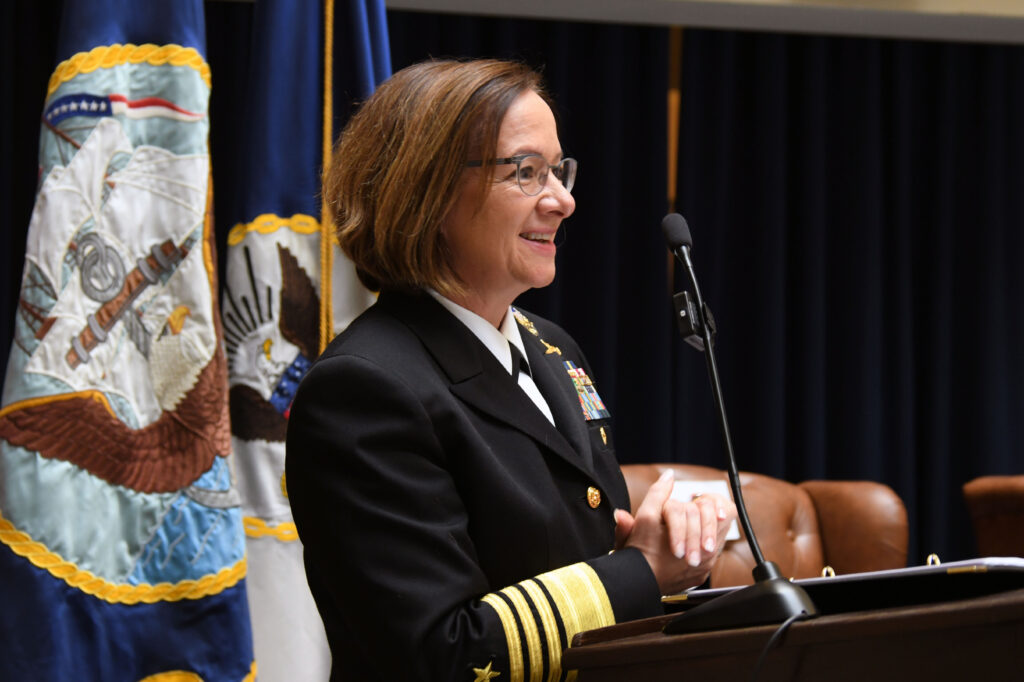
ARLINGTON, Virginia ─ The United States and its Navy are at a historical inflection point similar to ones it experienced in the past, and service officials and planners should respond the same way officials did then, said the Navy’s relatively new chief of naval operations, Admiral Lisa Franchetti.
Speaking Jan. 8 to the Surface Navy Association’s annual conference, Franchetti said the situation of the U.S. now is similar what was going on in the 1930s and 1970s. In both cases, visionary service leaders in peacetime looked ahead and prepared for war and built a Navy that was up to the task.
“I consider the 1930s and the 1970s as two decisive decades that sort of rhyme, in key ways, with where we are today,” she said. “… There are historical parallels that offer key lessons for us today.”
In the 1930s, the United States was still reeling from the Great Depression and had a shrinking shipbuilding base.
Fleet planners, their eyes on the threat from Imperial Japan, conducted a series of maneuvers, called fleet problems, to provide realistic training for Sailors. Planners also conducted extensive wargames. That let to a series of war plans that prompted the move from a fleet based on World War I battleships to a more integrated force that included aircraft carriers, dive bombers and torpedo bombers, all of which proved vital in World War II.
Ninety-five percent of the ships that fought in the war, including at the battles of Coral Sea and Midway, and in the Guadalcanal campaign, were fought with ships born from peacetime work.
“How we fight determines what we fight with. Warfighting concepts must drive the design of our warfighting platforms, our capabilities and our strategies,” Franchetti said.
In the 1970s, the Navy was a power projection force focused on supporting land troops in Asia amid a limited defense budget and high inflation. The nation had a hollowed-out shipbuilding industry and ended up with an aging fleet unprepared for escalating maritime competition from the Soviet Union.
Navy planners and leaders, including CNO Elmo Zumwalt and his successors, conceived of a fleet capable of global sea control, resulting in strategies that would “lay the intellectual groundwork” for the Navy’s weapons buys in the 1980s, which led to the introduction of the F/A-18 Hornet, the Los Angeles- and Ohio-class submarines, the Spruance and Arleigh Burke destroyers, Aegis, Harpoon and Tomahawk weapon systems, and others, she said.
Warfighting Lens
All of those systems were planned in peacetime but crucial when war came, Franchetti said, and the country is in a similar position now. She and other leaders are looking a new concepts, weapons and tactics through exercises and war games, as was done in the 1930s and 1970s, although now with advanced simulation technology.
“Today, our U.S. Navy is taking a similar approaching by viewing everything we do through a warfighting lens,” Franchetti said. “We have energized our wargaming enterprise at the Naval War College and at our Warfighting Development Center to empower leaders at all levels to think differently about how we need to operate in uncertain, complex and rapidly changing environments. Leaders who are ready to take initiative and be bold.”
The Navy is also undertaking fleet exercises and battle problems to develop and refine operational concepts to define the requirements for the future fleet, she said, including with Task Force 59, which has tested unmanned systems and other hardware and software in real-world situations.
“The actions taken during these respective decades remind us that we must be forward thinking in prioritizing our warfighting advantage, and that we must increase our capability and capacity in peacetime so we can be ready to surge effectively in war,” she said.






